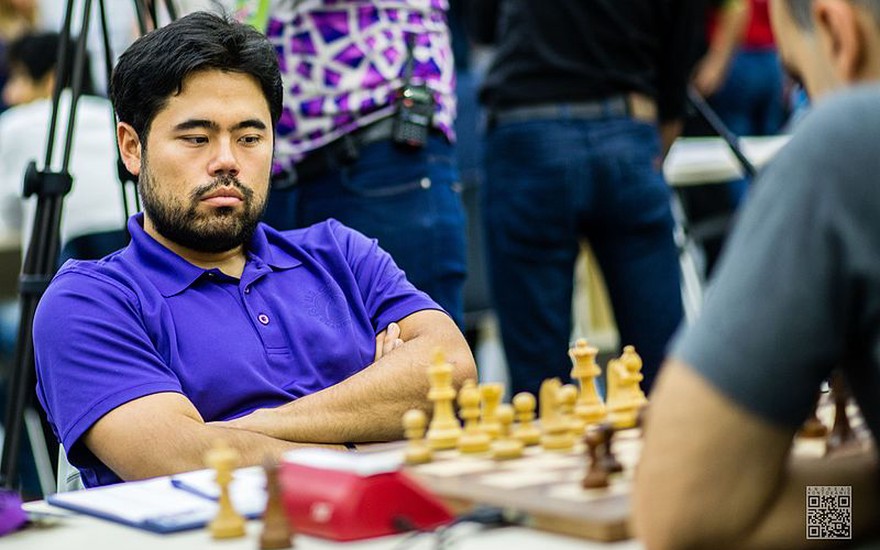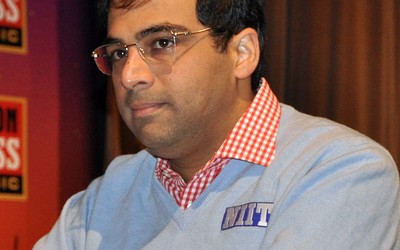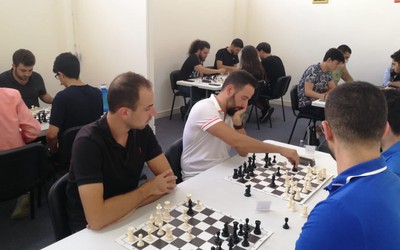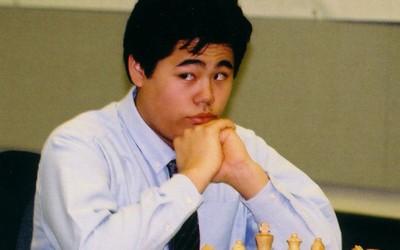
By Andreas Kontokanis from Piraeus, Greece - Hikaru Nakamura, CC BY-SA 2.0, https://commons.wikimedia.org/w/index.php?curid=52473561
Nakamura's Secret Weapon Against the Réti Opening - Introduction (Part 1)
In this series of articles, we will deeply analyze a very interesting and novel setup that Hikaru Nakamura employs with some frequency against the Réti Opening.Donations are much appreciated. All of my content and writings will be free forever according to the "Truthdoc code" (to be published some time next year) - help keep such content going strong :). Donate
Introduction
Wait a minute! "Secret" opening? Surely that's one of those clickbait tactics as there is no such thing as a "secret" opening ... No, this is not the case! Nakamura's opening weapon against the Réti Opening, which he often plays in blitz and rapid games, is legitimately "secret" because it a) has no name / is not recognized by any chess opening encyclopedia and b) is rarely (almost never!) played by anyone but superGM Hikaru Nakamura. That is why I am going to adopt the name "Nakamura Opening" in the remaining articles of this series.
As of December 5, 2021, 12:45 UTC, Hikaru has played 1098 online (blitz and bullet — mostly!) games in this opening, where he scored 86.1% wins, 9.6% losses, and 4.3% draws with it. Of course, the main reason for such a tremendous score is the simple fact that Hikaru is such a strong chess player. However, it has to be said that in many cases, the opening itself yields such simply-to-play attacking positions that you don't have to be Hikaru to win! Indeed, that is the aim of this series of articles: to teach non-Hikaru's how to win with the Nakamura Opening!
Update on January 12, 2022: I promised myself I wouldn't keep updating this series with new games, but it has to be said that after December 5, Hikaru played some games on Lichess (!) in this opening, so I will include those games, but hey, only those games!
This series of articles will include a whopping 90+ articles on the different setups that can be employed against the Nakamura Opening. The obvious question is: Why not write a book on this opening instead of so many articles? Well, the answer to that question will be covered in the coming "But Wait! Why Not a Book?" section. Before that, I would also like to mention that because not all of these articles have been completed yet (as of January 11, 2022), it remains to be seen what the final article count will be because I could potentially split some setups into two articles or combine two different setups into one article.
The Opening
Without further ado, I present to you the Nakamura Opening!
The opening is defined by the "Modern" (from the Modern Defense) bishop on g7, the pawn on d6, the bishop being on d7, and the queen being on c8.
For more information about this opening, check out the "General Principles of the Opening" section.
But Wait! Why Not a Book?
Well, there will be a book! Funnily enough, I initially wanted to write just one article about this opening. That being said, the more I searched, the more I noticed just how deep the possible ideas in this opening were. From just one article I eventually ended up at 90+, but I didn't want to stop there. Truly, the primary difference between this series of articles and the coming book is detail. While there will be so many articles, most of them are quite short and not so detailed; in comparison, the book will be much more comprehensive and will even include setups not covered in this article. I will now further note what the book will include in bullet form.
What the book includes:
- These articles will have a very game-specific approach — as in, only opening setups that were played against Nakamura will be covered in the articles; the book, in contrast, will analyze all potential opening setups that can be played against the Nakamura Opening. Indeed, in the book, opening setups that were never played against Nakamura will also be covered in just as much detail as those setups that did arise in practice.
- In the book, opening variations that Nakamura has never faced will be covered in detail, while in this series of articles, they will very rarely if ever be covered. Note that "opening variations" means possible deviations of a single opening setup. Therefore, the book will include all possible opening setups against the Nakamura Opening and also the many possible variations that could arise out of a single opening setup.
- As you will notice when you check out Nakamura's games in this opening, Nakamura almost always goes for a kingside attack. However, in some cases, it might not be justified to do so; indeed, quieter approaches are warranted against certain White opening setups. This facet of the Nakamura Opening will not be considered at all in the series of articles as, remember, we are taking a very game-specific approach. In contrast, the book will include a "Are we going to continue with the normal kingside attacking plan? YES! / NO!" section for each opening setup.
- The series of articles will only focus on games Nakamura has played in this opening. In the book, though, we'll also take a look at other people who have employed the Nakamura Opening in their own practice.
How Is This Opening Even Justified?
When one looks at the way Black is playing, the first reaction is surely indignant shock. "Black can't play like this" I expect many of you to say. "That kingside attack should never work" is the normal follow-up. Well, we have to keep in mind that White has already committed to castling in most cases while Black is playing the waiting game. In many setups as well, White cedes control of the center as they play in hypermodern style, giving Black the necessary time and flexibility to be able to launch a kingside attack. Furthermore, trading off White's light-squared bishop should never be underestimated: at many times, the opening of the h-file can spell White's doom. Of course, Black shouldn't always expect the kingside attack to work — as mentioned in the "But Wait! Why Not a Book?" section, it is sometimes best to not opt to go for a kingside attack against specific White setups. Indeed, Black is not at all committed to throwing the h-pawn down the board just yet and in some cases should castle short. Again, though, calmer and objectively better approaches against certain White setups will not be included in this series of articles!
General Principles of the Opening
Here are some general principles to keep in mind when playing the Black side of the Nakamura Opening:
- Have an eye on White's pawn structure, for while we will learn how to attack with the typical h5-h4-hxg3 plan, it is important to place some of the pieces differently against the various possible White setups.
- It is important for Black to play a game of cat and mouse and wait to see where White will castle. Indeed, Black's setup will make far less sense should White castle long, though that's admittedly rare. What's more common and more reasonable, though, is for White to not castle at all, so Black should shift their strategy accordingly.https://lichess.org/study/PVnmejD4/muCRDuX9#0
- The main plan of this opening is to attack on the kingside by playing h5-h4 and trading off light-squared bishops with Bh3-Bxg2. Then, Black should follow up with hxg3 and try to go for Qh3+ ideas.https://lichess.org/study/PVnmejD4/huCcjNe7#0
- Keeping in line with playing a game of cat and mouse, the g8-knight's development should be delayed because it blocks the dark-squared bishop. Usually, it's a good idea to have it participate in the attack when Black is preparing Qh3+ or sometimes to develop it to f6 after Black has played Qh3+.https://lichess.org/study/PVnmejD4/eERuQJWv#0
- Black's dark-squared bishop can also sometimes be a very powerful attacker, adding pressure from the e5-square on White's kingside. In other cases, the dark-squared bishop can add monstrous pressure to the long diagonal and make White have a tough time castling queenside or developing queenside pieces in general.https://lichess.org/study/PVnmejD4/MrkmMkzW#0
- Note that the opening setup isn't just about Qc8-Bd7 in many cases! Indeed, developing the knight to c6 is usually an integral part of the setup. From c6, the knight can add more firepower to Black's attack by later on jumping to e5 or sometimes d4. In many cases as well, the knight acts as a provocateur and entices White to push d5, radically changing the pawn structure and most of the time forcing White to play pawn structures they rarely have experience in.https://lichess.org/study/PVnmejD4/0Xi4RkYq#0
- Remember that this is a very aggressive and enterprising opening, so the rules of attacking chess apply. For example, don't trade off pieces, especially your attackers, and try to trade off your opponent's defending pieces (that bishop on g2!).
Caveats / Notes
- In the series of articles as well as in the book, the games in question won't be analyzed in detail because our main focus is on the Nakamura Opening. Of course, my "won't be analyzed in detail" may be another person's "super deep analysis"!
- The setups will be divided into three main sections: ones where White castles kingside, ones where White castles queenside, and ones where White doesn't castle at all.
- Another subdivision occurs based on whether or not White pushes d5 and takes the knight on c6.
- I have taken the liberty to name some setups after players who have played them the most or really strong players who have tried them out. Reading "the Caruana Variation of the Nakamura Opening" is much simpler than reading "White plays d5 - Ne5 - Nxe5 - Bxe5 with c4 only and follows up with e4 with castling"!
- Note that sometimes, a game where White castles queenside may be included in a "White doesn't castle at all" section. The reason is that in some games, White may delay castling so much that it's more precise to classify such an opening setup as "White doesn't castle at all," even though later on they might choose to castle queenside (or kingside).
- In the same vein, sometimes late transpositions into other setups will still be labeled as occurring in the "primary" setup and not in the "transposed to" setup. Again, late transpositions "lose information" more often than not.
Fun Statistics
Now it's time for some fun stats!
Player Who's Played the Most Against This System
That honor belongs to Boryboy, who played a startling 110 games against this setup! Second place goes to Keranke, who played "just" 50 games against this setup.
Shortest Decisive Game
9 moves is barely enough for Black to get their desired opening setup, but, somehow, Hikaru won twice in just 9 moves!
Longest Game
Yikes! The longest game played by Nakamura in this setup clocks in at 150 moves, which is much, much longer than the second longest game, which comes in at a mere 104 moves.
What's Coming Next
The ideal center (e4-d4) setup, subject of the first article of this series, is possibly the most principled variation: just grab the center while Black wastes time with their weird plan! However, castling kingside does justify Black's setup in a sense, so there is an argument to be made that White should just play for the ideal center but not castle at all.
More blog posts by FischyVishy

Attacking Chess Patterns: Grand Prix, Queen(1) Attack, and Grand Thorn
In this series of articles, I list and explain all kinds of chess patterns. Chess patterns are recur…
Why Bughouse Is Good for the Environment
Bughouse — Give it a try if you care about planet Earth.
Nakamura's Secret Weapon Against the Réti Opening - The Ideal Center (Part 2)
In this series of articles, we will deeply analyze a very interesting and novel setup that Hikaru Na…
